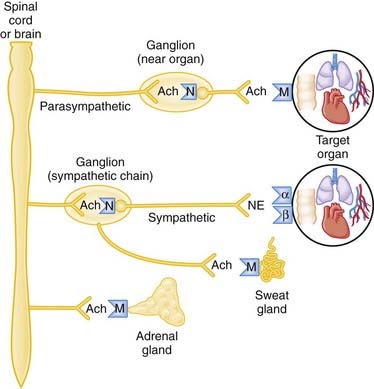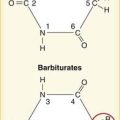Chapter 3 Autonomic Pharmacology
To understand autonomic function, and by extension to understand how to manipulate the ANS, you will need to understand how the two types of the ANS coexist and function, how each system exerts its effects, and finally what pharmacologic mechanisms exist to increase or decrease each component of the ANS. Memorization of the receptors, their distribution, and their effects is mandatory for achieving this goal and will enable you to accurately predict effects and side effects of drugs (Table 3-1).
| Receptor | Function | Distribution |
|---|---|---|
| Sympathetic | ||
| α1 | Constriction of smooth muscles | |
Autonomic Anatomy
Parasympathetic nerves are arranged in a craniosacral distribution. They:
The sympathetic nerves primarily arise from the thoracic and lumbar spinal roots.
Ganglia and Neurotransmitters
This is in contrast to sympathetic ganglia, which are located in the sympathetic chain that runs alongside the spinal column and are located at a distance from the organs. They are described as the “paravertebral (beside) and prevertebral (in front of) sympathetic chains, depending on their physical relationship to the vertebral column (Figure 3-1).
Autonomic Receptors
ACh binds to muscarinic and nicotinic receptors, abbreviated M and N.
 N receptors are in ANS ganglia and function as nerve to nerve neurotransmitters. N receptors are also important in nerve to muscle communication (the neuromuscular junction).
N receptors are in ANS ganglia and function as nerve to nerve neurotransmitters. N receptors are also important in nerve to muscle communication (the neuromuscular junction).The receptor types that are clinically important include M, N, α1, α2, β1, and β2. You must know the distribution and function of these receptors in the body to understand and predict the effects of drugs that influence the ANS (see Table 3-1).
Parasympathetic Drugs
Manipulating the Parasympathetic Nervous System
There are three ways to manipulate the PNS:
Effects of These Drugs
Instead of memorizing the effects of the individual drugs, it is better to learn the distribution of the receptors of the SNS and PNS and then, by logic, determine what the effects of the drugs would be (see Table 3-1). These drugs will have effects on the desired target organ but also have effects on other unintended target organs (which will cause side effects).
Sympathetic Drugs
 Note that the addition of the hydroxyl (OH) group is called hydroxylation, and the removal of the methyl (CH3) group is called demethylation.
Note that the addition of the hydroxyl (OH) group is called hydroxylation, and the removal of the methyl (CH3) group is called demethylation.Manipulating the Sympathetic Nervous System
Manipulating the SNS is a little simpler than manipulating the PNS.
 Fine print: You can give drugs that prevent release of NE from presynaptic nerve endings with ganglion blockers. This will result in a decrease of ganglionic transmission and result in decreased SNS activity. However, these drugs are used less and less commonly because of side effects.
Fine print: You can give drugs that prevent release of NE from presynaptic nerve endings with ganglion blockers. This will result in a decrease of ganglionic transmission and result in decreased SNS activity. However, these drugs are used less and less commonly because of side effects. Fine print #2: Some drugs are inhibitors of enzymes that degrade adrenergic molecules. These drugs (catechol-O-methyltransferase [COMT] inhibitors and monoamine oxidase [MAO] inhibitors used for Parkinson’s disease and depression) are designed to influence the adrenergic transmitter levels in the brain but are not intended to affect changes in the SNS. However, they can result in some systemic SNS changes.
Fine print #2: Some drugs are inhibitors of enzymes that degrade adrenergic molecules. These drugs (catechol-O-methyltransferase [COMT] inhibitors and monoamine oxidase [MAO] inhibitors used for Parkinson’s disease and depression) are designed to influence the adrenergic transmitter levels in the brain but are not intended to affect changes in the SNS. However, they can result in some systemic SNS changes.














































































